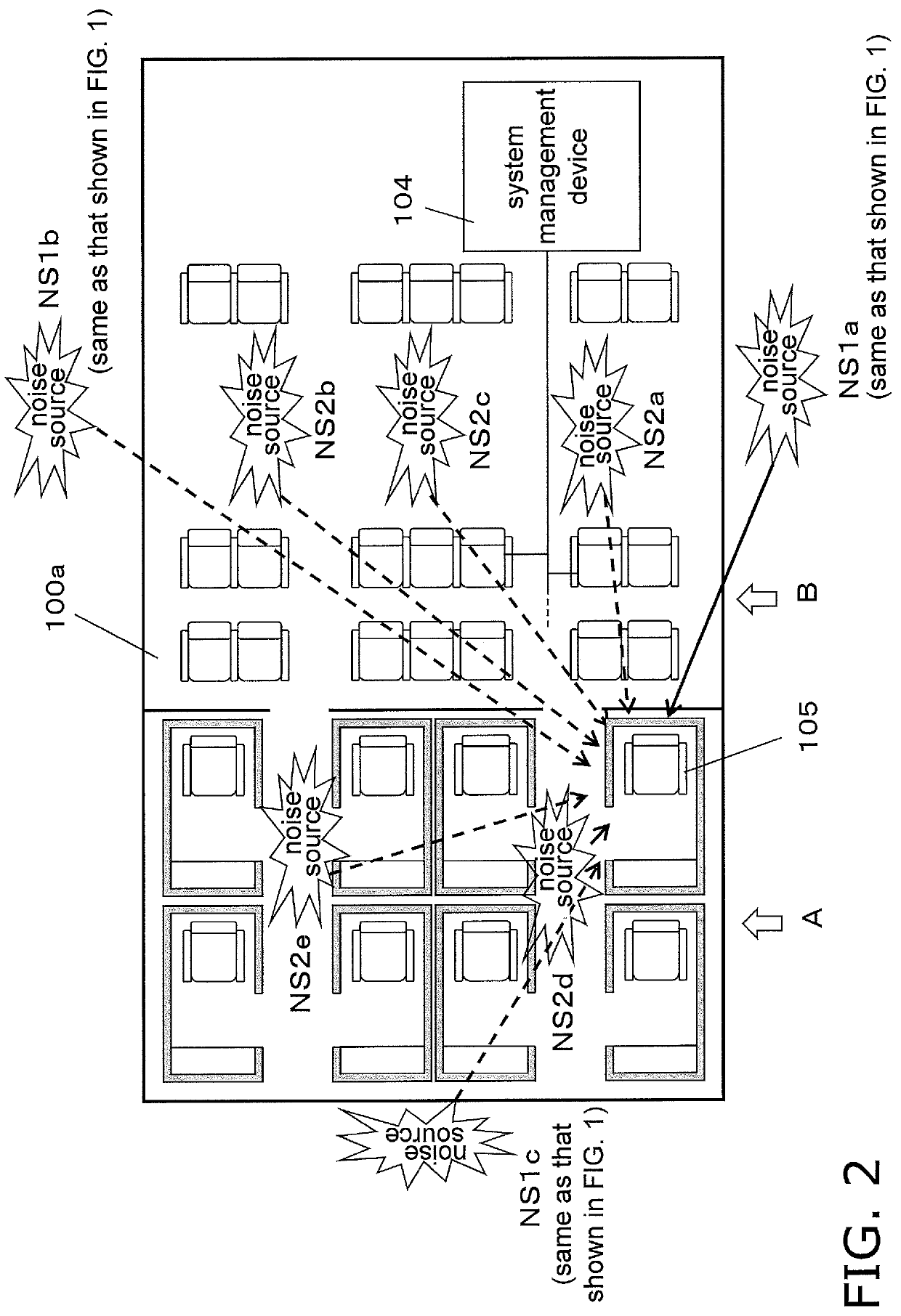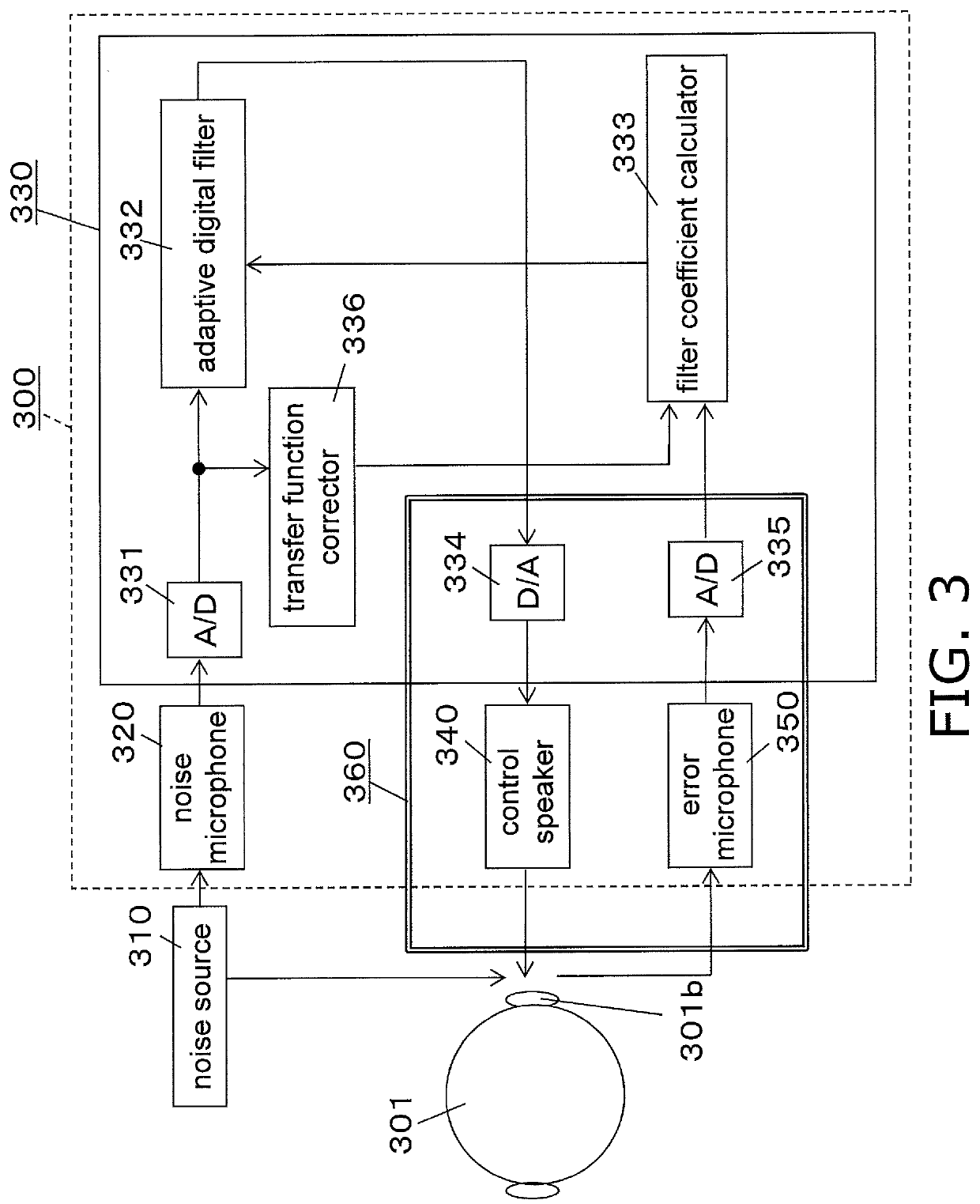Noise reduction device and noise reduction system
a noise reduction device and noise reduction technology, applied in the field of seat noise reduction, can solve the problems of less convenient use of usage sites, less noise environment for users, and difficulty in adjusting the seat position, so as to maximize the noise reduction effect, reduce the effect of noise, and reduce the effect of maintenan
- Summary
- Abstract
- Description
- Claims
- Application Information
AI Technical Summary
Benefits of technology
Problems solved by technology
Method used
Image
Examples
embodiment 1
[0059]A noise reduction device in an embodiment of the present disclosure will now be described by citing a case in which the device is mounted in an aircraft. First, the acoustic environment in the aircraft requiring installation of noise reduction devices will be described through reference to FIGS. 1 and 2.
[0060]FIG. 1 is a plan view showing the installation environment of noise reduction devices in an embodiment of the present disclosure. As shown in FIG. 1, an aircraft 100 comprises engines 102a and 102b on left and right wings.
[0061]From the standpoint of the acoustic environment of an aircraft, the engines play a major role as a source of noise not only because of their running noise, but also because of reverberations of air flow during the flight and so forth. From the standpoint of passenger service, the engines 102a and 102b are external noise sources NS1a and NS1b that affect parts of the aircraft located at seat rows 103a, 103b, and 103c installed in a cabin A (such as ...
embodiment 2
[0107]FIG. 10 is a flowchart illustrating an operation example of the noise reduction device in Embodiment 2 of the present disclosure.
[0108]In this embodiment, a plurality of noise reduction devices are installed in each seat of an aircraft to constitute a noise reduction system.
[0109]In this flowchart, the operation at each seat is illustrated in an example in which information between the plurality of seats shown in FIG. 11 is managed by a server (system management device; not shown). In FIG. 11, the seats are numbered from rows one to four from front to rear, and the lines of seats are lettered line A, line C, . . . , line K from left to right. For example, the left-front seat is called seat 1A, and the seat in row 2 and line H is called seat 2H. The steps of the flowchart shown in FIG. 10 will be described below.
[0110]When the power to the noise reduction device is turned on, the flow proceeds from step S010 to step S011. In step S011, it is determined whether or not identifica...
third embodiment
[0135]FIG. 19 is a block diagram showing the basic configuration for performing the identification operation with the noise reduction device in an embodiment of the present disclosure.
[0136]In carrying out an identification operation for each noise reduction device, the system management device 501 first notifies the seat driver 581 to create a seat actual usage state in which noise reduction effectively acts at each seat.
[0137]For example, if the fully reclined bed mode, in which the seat is reclined horizontally for sleeping, is the actual usage state of noise reduction, the seat driver 581 puts the seat in bed mode.
[0138]When the identification operation is commenced at each seat, the identification controller 538 starts the identification operation after the seat detector 582 has detected that the seat is in the actual usage state of noise reduction.
[0139]The seat detector 582 may detect that a seat has been fully reclined and is in the bed mode position, or may detect that the ...
PUM
 Login to View More
Login to View More Abstract
Description
Claims
Application Information
 Login to View More
Login to View More - R&D
- Intellectual Property
- Life Sciences
- Materials
- Tech Scout
- Unparalleled Data Quality
- Higher Quality Content
- 60% Fewer Hallucinations
Browse by: Latest US Patents, China's latest patents, Technical Efficacy Thesaurus, Application Domain, Technology Topic, Popular Technical Reports.
© 2025 PatSnap. All rights reserved.Legal|Privacy policy|Modern Slavery Act Transparency Statement|Sitemap|About US| Contact US: help@patsnap.com



